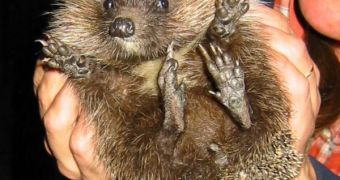The oldest ancestor of the hedgehogs could be an 80 million years old mammal found in Mongolia (which lived during the dinosaur era). The oldest known hedgehogs lived in Europe, 45 million years ago. In Africa, the oldest hedgehogs remains are 30 million years old. 10 million years ago, there were hedgehogs in North America; today there are no hedgehogs there. The modern genera are 15 million years old, and during the Ice Age made southward-northward movements, depending on the glaciers' movement.
Hedgehogs are 35-45 more resistant to the venom of viper or wasp than a Guinea pig the same size is. Thus, even if they kill and consume venomous snakes, they can be killed sometimes by their venom. As the hedgehog has a slow metabolism and blood circulation, the venom reaches harder target tissues, giving time to the immune system of the hedgehog to react. A hedgehog can tolerate doses of arsenic that may kill 25 persons. At 1 kg (2.5 pound) in weight, the hedgehog is the largest insect eater in Europe.
The spines are 2-3 cm long, being around 5,000 per individual. They are hard, yellowish in the middle and brown to the tip. Hedgehogs oint their spines with saliva and the inoculated saliva causes a scorching sensation in stung animals. In the wild they frequently enter some kind of a trance after licking themselves with saliva till it gets foamy. The head, abdomen and feet are covered by gray-brown hair.
In March starts the mating season of the hedgehogs, when the male attracts the female through dances accompanied by grunts and raucous yells. When mating, the female tilts down the dorsal spines. The female remains in the leaf sheeted nest 4-5 days before giving birth to 3-6 offspring, blind and with soft spines. If the female is disturbed in the first 24 hours after giving birth, she will eat the offspring. Later, she will transport them to a new nest. The offspring can roll at 11 days old, and at four weeks, they already have 3,000 spines. Now they can accompany their mother in her forages, in Indian file, learning how to find food. Hedgehogs live 8-10 years.
The hibernation nest is covered with a layer of dead leaves and mosses 10 cm (4 in) thick. The chamber temperature varies between 1? to 5? C, while outside the temperature can be -18? to -8? C. During hibernation, the body temperature of the rolled hedgehog drops from 36? C to 10? C (and even to 1?C in case of severe cold). The heart beat decreases from 190 per minute to 20, and the number of breathes to 10 per minute. The hibernation lasts 8 months in Scandinavia, 6 months in west and central Europe, few weeks in New Zealand, while in the Mediterranean area they do not hibernate, just 'estivate'. During the day, the hedgehog may rest in a shelter made of dry leaves amongst the roots of dead trees.
When attacking a toad, the hedgehog bites first its venom glands, then it licks its spines with the mix of saliva and toad venom. Sometimes, the hedgehog rubs its spines against the captured toad. These spines provoke a burning sensation that lasts for about one hour, while spines lacking the toad venom are not so painful.
Hedgehogs live up to 1,000 m (3,300 ft) altitude, rarely to 2,000 m (6,600 ft) in areas with warm summers. Hedgehogs avoid coniferous forests and swamps, preferring gardens and plantations. They feed during the night, ransacking avidly the leaf litter in search of molecrickets, locusts, crickets, cockchafers and other beetles, snails, earthworms, and even lizards and mice; also eggs and chicks of birds nesting on the ground.
The main predators of the hedgehogs are the polecat, prey birds, wild boars, owls, stray dogs and foxes. When attacked, the caudo-dorsal, orbicular and skin muscles allow a hedgehog to roll up in three seconds. It can remain in this position for hours. Foxes unroll the hedgehogs by bowling them to a water. Owls have to take them by surprise, before the rolling, to catch them by the muzzle or abdomen.

 14 DAY TRIAL //
14 DAY TRIAL //